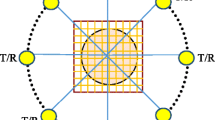Abstract
Ultrasonic computed tomography based on back scattering theory is the most powerful and accurate tool in ultrasound based imaging approaches because it is capable of providing quantitative information about the imaged target and detects very small targets. The duple-frequency distorted Born iterative method (DF–DBIM), which uses density information along with sound contrast for imaging, is a promising approach for imaging targets at the level of biological tissues. With two frequencies f1 (low) and f2 (high) through \({\mathbf{N}}_{{{\mathbf{f}}_{1}}}\) and \({\mathbf{N}}_{{{\mathbf{f}}_{2}}}\) iterations respectively, this method is used to estimate target density along with sound contrast. The implications of duple-frequency fusion for the image reconstruction quality of density information along with sound contrast based ultrasound tomography have been analyzed in this paper. In this paper, we concentrate on the selection of parameters that is supposed to be the best to improve the reconstruction quality of ultrasound tomography. When there are restraints imposed on simulated scenarios to have control of the computational cost, the iteration number \({\mathbf{N}}_{{{\mathbf{f}}_{1}}}\) is determined resulting in giving the best performance. The DF–DBIM is only effective if there are a moderate number of iterations, transmitters and receivers. In case that the number of transducers is either too large or too small, a result of reconstruction which is better than that of the single frequency approach is not produced by the implementation of DF–DBIM. A fixed sum \({\mathbf{N}}_{{{\mathbf{iter}} }}\) of \({\mathbf{N}}_{{{\mathbf{f}}_{1}}}\) and \({\mathbf{N}}_{{{\mathbf{f}}_{2}}}\) was given, the investigation of simulation results shows that the best value of \({\mathbf{N}}_{{{\mathbf{f}}_{1}}}\) is \(\left[{\frac{{{\mathbf{N}}_{{{\mathbf{iter}}}}}}{2} - 1} \right]\). The error, when applying this way of choosing the parameters, will be normalized with the reduction of 56.11%, compared to use single frequency as used in the conventional DBIM method. The target density along with sound contrast is used to image targets in this paper. It is a fact that low-frequency offers fine convergence, and high-frequency offers fine spatial resolution. Wherefore, this technique can effectively expand DBIM’s applicability to the problem of biological tissue reconstruction. Thanks to the usage of empirical data, this work will be further developed prior to its application in reality.



















Similar content being viewed by others
References
Pierce AD, Beyer RT. Acoustics: an introduction to its physical principles and applications. In: Acoustical society of America. 1990.
Jonathan M, Michael O. Quantitative ultrasound in soft tissues. Heidelberg: Springer; 2013.
Goss SA, Johnston RL, Dunn F. Comprehensive compilation of empirical ultrasonic properties of mammalian tissues. J Acoust Soc Am. 1978;64(2):423–57.
Goss SA, Johnston RL, Dunn F. Compilation of empirical ultrasonic properties of mammalian tissues II. J Acoust Soc Am. 1980;68(1):93–108.
Mast TD. Empirical relationships between acoustic parameters in human soft tissues. Acoustics Research Letters Online. 2000;1(2):37–42.
Yang JN, Murphy AD, Madsen EL, et al. A method for in vitro mapping of ultrasonic speed and density in breast tissue. Ultrason Imaging. 1991;13(1):91–109.
Nassiri DK, Hill CR. The use of angular acoustic scattering measurements to estimate structural parameters of human and animal tissues. J Acoust Soc Am. 1986;79(6):2048–54.
Waag RC, Dalecki D, Christopher PE. Spectral power determinations of compressibility and density variations in model media and calf liver using ultrasound. J Acoust Soc Am. 1988;85(1):423–31.
Devaney AJ. Inversion formula for inverse scattering within the Born approximation. Opt Lett. 1982;7(3):111–2.
Slaney M, Kak AC, Larson LE. Limitations of imaging with first order diffraction tomography. IEEE Trans Microwave Theory Tech. 1984;32(8):860–73.
Lavarello R, Michael O. Density imaging using a multiple-frequency DBIM approach. IEEE Trans Ultrason Ferroelectr Freq Control. 2010;57(11):2471–9.
Tijhuis AG, Belkebir K, Litman ACS, et al. Multiple-frequency distorted-wave Born approach to 2D inverse profiling. Inverse Prob. 2001;17(6):1635–44.
Tran Q-H, Tran D-T, Huynh HT, Long T-T, Nguyen L-T. Influence of dual-frequency combination on the quality improvement of ultrasound tomography. Simulation. 2016;92(3):267–76.
Lavarello R, Michael O. Tomographic reconstruction of three-dimensional volumes using the distorted born iterative method. IEEE Trans Med Imaging. 2009;28(10):1643–53.
Golub GH, Hansen PC, O’Leary DP. Tikhonov regularization and total least squares. SIAM J Matrix Anal Appl. 1999;21(1):185–94.
Lavarello R, Michael O. A study on the reconstruction of moderate contrast targets using the distorted Born iterative method. IEEE Trans Ultrason Ferroelectr Freq Control. 2008;55(1):112–24.
Lavarello Roberto J, Oelze Michael L. Density imaging using inverse scattering. J Acoust Soc Am. 2009;125(2):793–802.
Lavarello RJ, Oelze ML. Two approaches for tomographic density imaging using inverse scattering. In: 2008 IEEE ultrasonics symposium. IEEE, 2008. p. 1298–1301.
Lavarello R. New developments on quantitative imaging using ultrasonic waves, Ph.D. Dissertation, University of Illinois at Urbana-Champaign. 2009.
Kak AC, Slaney M. Principles of computerized tomographic imaging. New York: IEEE Press; 2001. p. 248–9.
Author information
Authors and Affiliations
Corresponding author
Ethics declarations
Conflict of interest
The authors declare that they have no conflict of interest.
Ethical approval
This article does not contain any studies with human participants performed by any of the authors.
Additional information
Publisher's Note
Springer Nature remains neutral with regard to jurisdictional claims in published maps and institutional affiliations.
Rights and permissions
About this article
Cite this article
Huy, T.Q., Cuc, N.T., Nguyen, V.D. et al. Tomographic density imaging using modified DF–DBIM approach. Biomed. Eng. Lett. 9, 449–465 (2019). https://doi.org/10.1007/s13534-019-00129-5
Received:
Revised:
Accepted:
Published:
Issue Date:
DOI: https://doi.org/10.1007/s13534-019-00129-5




